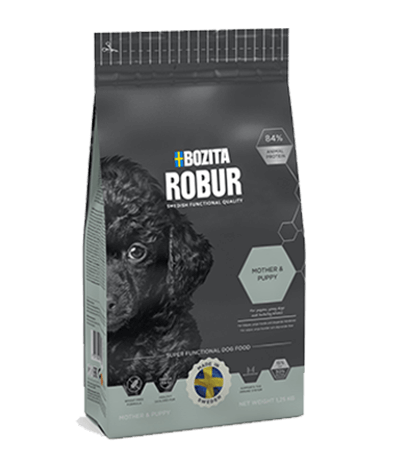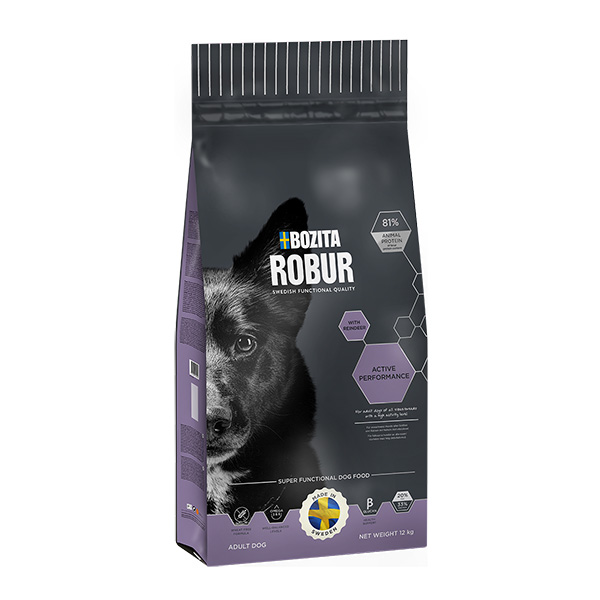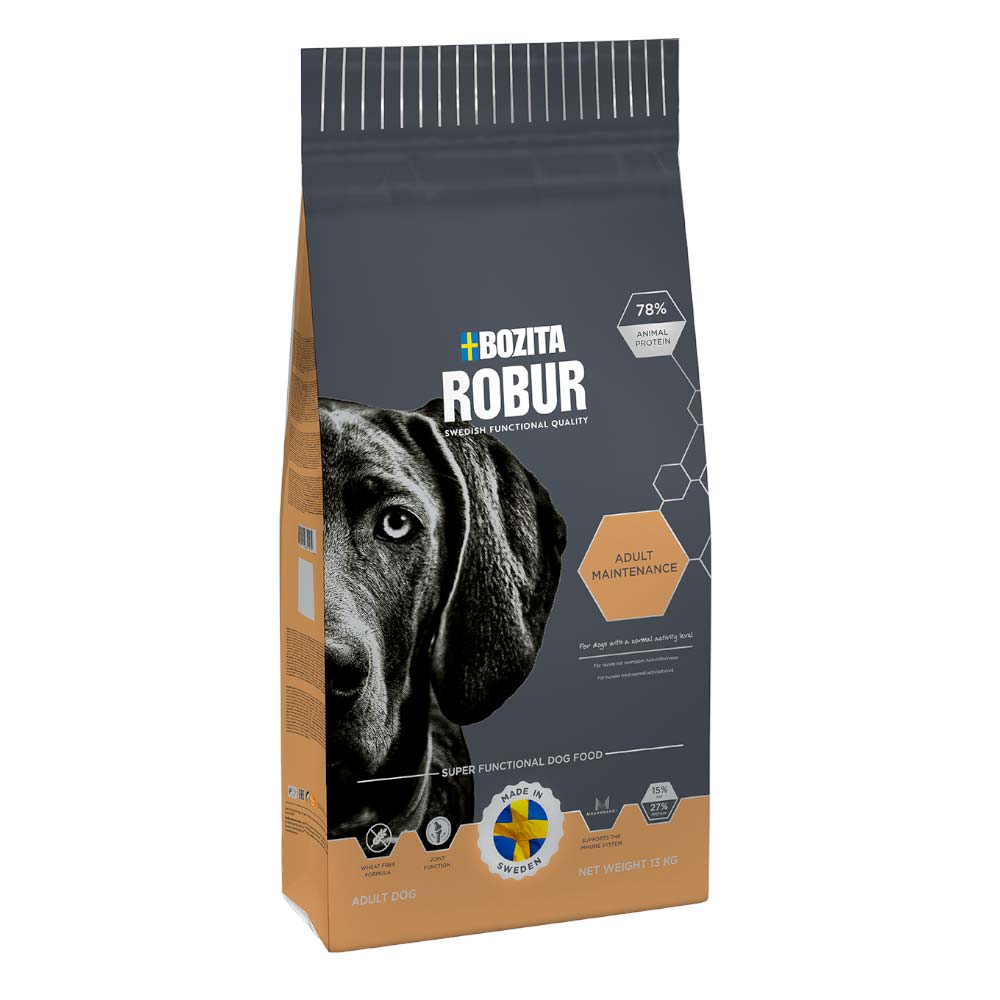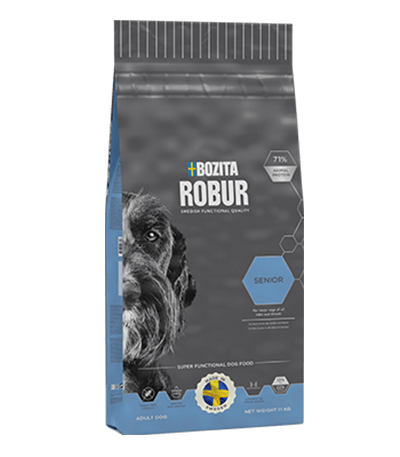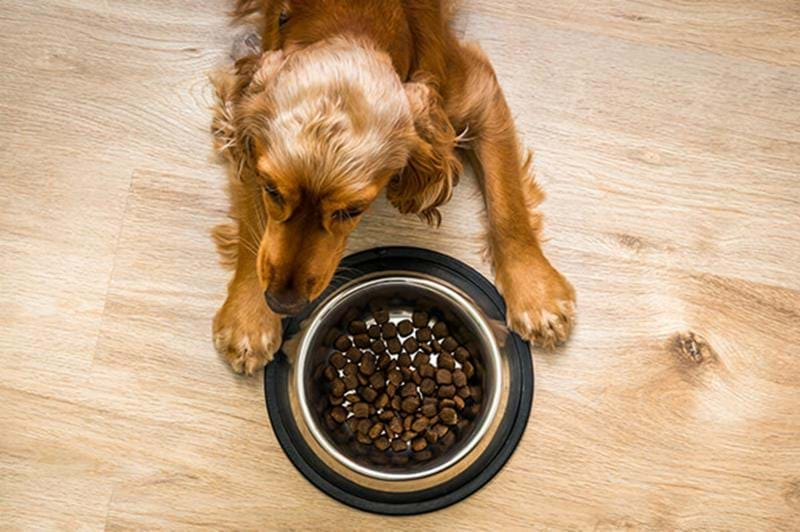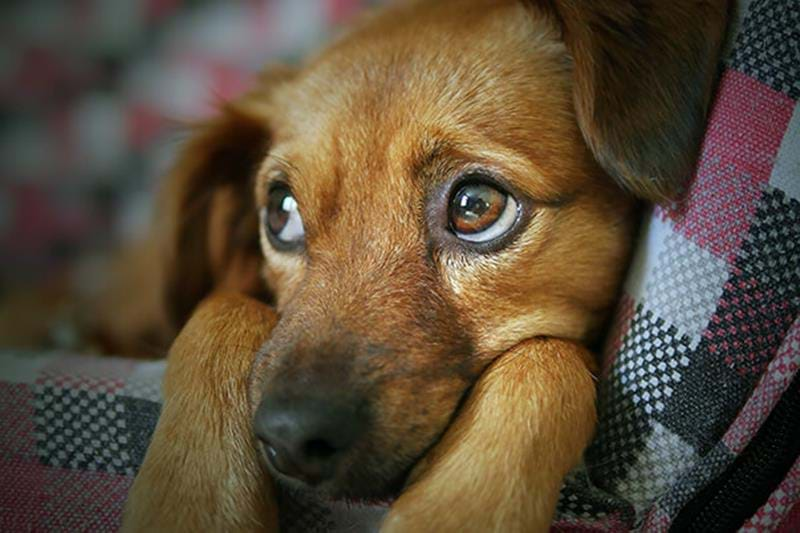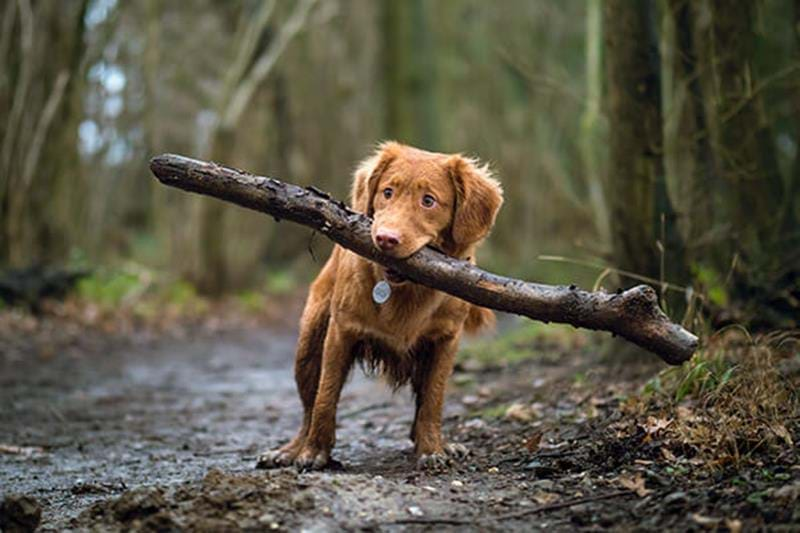Puppies are born relatively helpless, but they quickly grow up to be independent individuals with a unique personality. Following a dog’s journey through the phases of life is an amazing experience. By understanding the puppy’s development and the dog’s different stages of development, we can better understand its behaviour and how we should respond to it.
On this page
- Dog’s prenatal period
- Dog’s neonatal period (0–2 weeks)
- The puppy’s transition period (2–4 weeks)
- Dog’s socialisation period (4–12 weeks)
- Dog’s juvenile period or young adolescence stage (12 veckor–7 months)
- Dog’s adolescence (7–18 months)
- Sexual maturity and puberty (2 years)
- Adult dog (2,5–3 years)
DOG’S PRENATAL PERIOD
The time puppies spend in the dam’s womb is usually called the prenatal period. It lasts somewhere around 58-68 days, and the puppy’s development begins during this phase.
A pregnant dog should live just as usual, albeit with less activity and more care in the last weeks of pregnancy. She should not be exposed to unnecessary stress. Recent research indicates that puppies are affected by their mother already in the prenatal stage, and it is probably the amount of stress and sex hormones that the mother secretes – which is transmitted to the puppies via the placenta – that affects the puppies the most. Prenatal stress can affect the puppies’ brains and organs causing them to establish behaviour to stressful situations before they are even born. It can make puppies less curious, they might have a decreased ability to learn, they may be more aggressive or have changes in sexual behavior.
During pregnancy, the mother needs more nutritious food than usual, because she no longer eats just for herself. There is really good food that can be given to both the mother both during pregnancy and lactation, and also growing puppies and young dogs. Among Bozita’s dry food for dogs, you’ll find Bozita Robur mother and puppy.
Further reading
- Balanced dry food for puppies, young dogs and pregnant and lactating bitches
- Things to keep in mind when feeding pregnant and lactating bitches
THE PUPPY’S FIRST STAGE – THE NEONATAL PERIOD
When puppies are born, they are virtually helpless and strongly dependent on their mother. During the neonatal period, they mostly sleep and are active only 2–15 percent of the day. They spend most of their waking time suckling. However, puppies may scream and whine to communicate how they are feeling and their location.
SUCKING BEHAVIOUR AND MILK KNEADING
Sucking behaviour and “milk trampling” (the puppies knead with their paws on the mother’s teats to stimulate the milk) are innate behaviours. Looking for food is a natural part of the puppy’s development, and the mother and her puppies usually manage the suckling themselves. However, they might need a helping hand if the puppies do not find the right one or if the mother is inexperienced.
THE PUPPY’S DEVELOPMENT – BRAIN, VISION AND HEARING
At birth, the puppies’ brains are relatively undeveloped and EEG studies have shown there is relatively low brain activity. Their eyes are closed, and the optic nerve is undeveloped so they cannot see, and because the ear canals are closed, they cannot hear either. Still, they can already react to bright light and loud noises. It is not yet known exactly how.
KEEPING WARM
This early in life, puppies cannot regulate their own body temperature yet. Therefore, they depend on their mother and litter mates to maintain the right temperature. They need to stay in a warm place as well.
BLADDER AND INTESTINES
The bladder and intestines work, but the puppies cannot empty any of them on their own for the first two weeks. Therefore, the mother licks them to stimulate them to pass urine and faeces. Since puppies cannot take care of these functions themselves, it is vital that the mother helps them.
TOUCH AND PAIN
The puppies can feel touch on the head and can also feel pain, but not to any great extent.
PUPPY’S DEVELOPMENT – THE TRANSITION PERIOD
The transition period is a short but eventful time in puppies’ lives when dramatic changes take place. A whole new world opens up when the puppies open their eyes, begin to hear and begin to explore. Their brain begins to activate in earnest, and they are mature enough for more complex learning.
AFTER THE PUPPY’S FIRST WEEKS – EYES AND HEARING
The puppies open their eyes after 12–13 days. The contraction of the pupil to bright light starts a few days later and the puppies begin to follow moving objects. They probably only see in tones with little or no details, but as the pupils flex, the muscles in the eye, the optic nerves and the visual centre in the brain develop more and more, helping to develop their vision. When the puppies are 28 days old, they look like an adult dog.
At the end of the transition period, the hearing also begins to work fully, and the puppies react to loud noises. When this happens, they have already had their eyes open for a few days and can fix their gaze. It is also now that they begin to show the first signs of fear and may withdraw in the event of sudden visual or sound impressions. Hearing tests show that puppies hear like an adult dog and orient themselves in relation to sound at 3-4 weeks of age.
SITTING, STANDING, WALKING AND PLAYING
When the puppies are two weeks old, the nerve pathways in the front legs are developed and they can sit. One week later in the puppy’s development, the hind body’s motor skills have also improved so that they can stand and, a few days later, walk (even if it is a bit clumsy at first) and wave their tail. They also start to play with each other little by little. Between 2 and 4 weeks after birth, the puppies’ pain reactions are also fully developed.
WAGGING THE TAIL, GROWLING AND BARKING
Around 3-5 weeks into the puppy’s development, the puppies start behaving more like a dog. They wag their tails, growl and bark. They play with their siblings and/or their mother and are more contact-seeking and curious. They are happy to explore further afield, if they can.
TEETH, FULFILLING NEEDS AND ASSOCIATIVE LEARNING
During the transition period, the puppies’ canines in the upper jaw begin to grow and they can begin to learn to chew food. They can also independently fulfil their needs themselves, no longer needing the mother’s help. During this period of the puppy’s development, they start connecting a certain stimulus to a reaction (so-called associative learning). For example, they start salivating when they hear the rattle of the food bowls, because they have learned that the sound means it’s time for food.
SUCKING INDEPENDENTLY
Until the age of 4 weeks, the mother takes the initiative for breastfeeding. Now the puppies are starting to take the initiative and beg their mother to breastfeed. A mother-child conflict occurs, which is common in dogs. It is in the puppies’ interest to breastfeed for as long as possible, but it is in the mother’s interest to wean as soon as possible, because breastfeeding is very energy-consuming for her.
PUPPY’S DEVELOPMENT – THE SOCIALISATION PERIOD
At four weeks, the puppies are fully developed small dogs and enter perhaps the most important period in their lives, the socialisation phase. During this period in the puppies’ development, they are extremely receptive to social stimuli. They are curious, memorise everything they are exposed to and can form new bonds with different individuals. You usually start introducing the puppies to new surroundings and other experiences at this key stage.
Research shows that the puppy’s experiences during the socialisation period strongly affect the puppy’s general development. Puppies that do not have much contact with humans often become less contact-seeking and can be more difficult to handle, for example, during training, veterinary visits and care.
As a breeder, you have a responsibility during this development period to let the puppy be part of family life without the support of his siblings. The puppy must be exposed to everyday activities, people and sounds before the fear reactions are fully developed in earnest. From weeks 5–6, contact with people should be increased gradually – play, cuddle, lift and take out each puppy on their own every week.
Further reading about the puppy’s development and socialisation
LEARN THE SOCIAL SIGNALS
At 5–7 weeks, the puppies go on longer adventures and play intensively with each other and with other members of the pack, on average half of their waking time. They like to explore their surroundings with their teeth. Now the so-called bite inhibition takes place – how hard can you bite your siblings before they scream in pain and the play is interrupted? The puppies scream partly because it hurts and partly because puppies at this age are a little dramatic. During this phase of the puppy’s development, they also learn the dogs’ signalling system and how to get along with each other. If there are other adult dogs in the household, they are usually involved in the puppies’ development of the social signals. It is therefore important that the puppies are allowed to spend time with other dogs.
THE MOTHER BEGINS TO WEAN AND THE PUPPIES MOVE ON TO SOLID FOOD
At this time, the mother begins to think that the puppies are annoying and leaves them alone for longer periods to also encourage weaning. Weaning is usually a gentle process, but if the mother senses the puppies are being stubborn, she can become irritated and snap at them. In the wild, she would have received help from other adult dogs. This opportunity is rarely found with breeders, but the breeder can help and relieve her so that she has time for herself.
At 5–6 weeks of age, the puppies eat almost like an adult dog, although they may still have difficulty chewing food that is too hard. They begin to defend objects and food by growling and putting their paws over and they shake toys like an adult dog shakes its prey. In addition, the hierarchy begins to take form, even if it changes constantly during the puppies’ development.
Further reading
WHEN IS IT TIME TO MOVE DURING THE PUPPY’S DEVELOPMENT?
In the middle of the socialisation period, at 8–9 weeks of age, most puppies move away from the breeder, the mother and their littermates to their new owner. This is a good age to be placed in a new home. The puppy is imprinted on their mother, siblings and possibly other dogs in the group and now is a good time for the puppy to bond with a new family. To build on this bond and help the socialisation and environment training develop further, the new owner should continue along the same path as the breader.
If the puppy is separated too early
According to the Swedish Board of Agriculture’s regulations, a puppy cannot be separated from its mother (more than temporarily) until the day it turns 8 weeks old, unless in special circumstances. If the puppy is separated from its mother too early, it is not sufficiently imprinted on its pack of dogs. It will probably have problems interacting with other dogs.
TRAINING IN DIFFERENT ENVIRONMENTS WITH THE NEW FAMILY
Between 8 and 12 weeks is a good period in the puppy’s development for training and learning. During this learning period, the puppy’s experiences are likely to become permanent memories more and more often. It is also a crucial period from a social point of view. During the behavioural training in different environments, the new owner continues to lay the foundation for the dog’s future character. It is of the utmost importance that the dog meets new people, animals and situations in a calm and unstressful way. It must become used to new environment slowly and steadily. The owner must take care of security, intimacy and care. If the puppy is exposed to strong sensory impressions during this period, it might be shocked and affected for the rest of its life.
Further reading on the puppy’s development and training
THE DOG’S JUVENILE PERIOD OR YOUNG ADOLESCENCE STAGE
During the puppy’s first year, it enters the juvenile period or young adolescence stage. The period between 12 weeks and 7 months is called the juvenile period. In this stage, the puppy grows physically and mentally into an adult dog with its own personality.
During the juvenile period, the desire to make new contacts decreases whilst various fears can become greater. You can train your dog during this period, but this involves more work and patience to get the same results as earlier. During this period in the puppy’s development, you should dedicate time for training (come here, sit, stay) and focus on good habits and clear rules to follow. At this time, you can also start training your dog to be alone for short periods.
Further reading
- Find dog training courses as well as other activities and courses that suit you and your puppy
- Independence training – train your puppy to be alone
At this stage, the puppy plays for more than half of his time whilst awake. While playing, puppies train their muscles and mind and learn their strengths and weaknesses. Go down to the floor and play with the puppy to strengthen the relationship between you. Your puppy will most likely bite every now and then. To make it stop biting, you can get up and walk away or distract the dog with a toy. This helps the young dog learn what can be bitten and what cannot.
The period between 13 and 16 weeks is sometimes called “semi-maturity”. During this period of the puppy’s development, testosterone levels in both males and females increase, and the puppy tries to find its place among humans and other dogs.
Around the age of five months, the puppy’s hunting interest increases. You notice this when the puppy is more interested in scents and starts to follow different tracks. Many people say that they experience it as if the puppy lives in his own world and does not really listen – for example, it doesn’t come when called. This does not mean it’s disobedient. The puppy is simply so focused that it does not hear you.
At 6 months, most puppies are completely housetrained. If you pay enough attention, you will learn to spot the signs that your dog needs to go for a walk. In the beginning, puppies can’t hold their bladder, but at 6 months they usually manage long enough until you take them out for a walk.
PUPPY’S DEVELOPMENT – TEETH
Between weeks 16 and 20, the sharp puppy teeth loosen and are replaced by new, much stronger permanent teeth. How the puppy experiences teeth development is highly individual. Some puppies bite everything and others do not react at all.
Puppies usually swallow the deciduous teeth. Check that all the deciduous teeth come loose and that the permanent tooth grows properly. Otherwise, their bite may have problems. Deciduous teeth that do not fall out on their own may need to be surgically removed. In addition, you should introduce a daily toothbrushing routine to prevent future problems with teeth.
Further reading
PUPPY’S DEVELOPMENT – THE FEAR PERIOD
Months between 5 and 7 are sometimes called the “fear period”. The puppy suddenly becomes afraid of everyday situations that it previously handled without problems. For example, it might be afraid of the dark and react to shadows, bicycles and fluttering flags. The puppy reacts suspicious, barks, refuses to approach or backs away out of fear. In such situations, do not try to force your dog and stay calm. Also, do not try to distract or entice it with pats or sweets and reinforce the fear by feeling sorry for it or taking detours to avoid the trigger. Instead, be completely indifferent and move on as if nothing had happened. Try to pass the scary place several times in the upcoming weeks until it is completely normal again.
Further reading
DOG’S ADOLESCENCE
SEXUAL MATURITY, OFTEN CALLED TERRIBLE TWOS OR AWKWARD AGE
Somewhere between months 7 and 9, the puppy’s development has come so far that the dog becomes physically sexually mature (for larger dog breeds, sexual maturation can take up to about 18 months). This is when the female is on heat for the first time and the male dog (and some females as well) starts marking their territory with urine.
You can now notice a clear change in your dog’s behavior. Before hormone levels are stabilised, the brain can be a bit haywire. The desire to play decreases, both sexes (a little less distinctive in females) become less social, more hesitant and more aggressive towards unfamiliar dogs. The stage is often called terrible twos or awkward age, and many dog owners notice their dog seems to stop listening and suddenly forgets how to do things.
During this period, the young dog is less receptive to training. If you have not already taught your dog the difference between activity/training and rule/social requirements, it is essential you undertake these lessons now. Otherwise, stress can arise with a confusion between the two.
Further reading
Even if your puppy is now sexually mature and can physically have puppies, it is not mentally mature to do so. In Sweden, it is forbidden by law to mate a female that is younger than 18 months. Many breeding clubs have also set a limit that the female must be 2 years old before she has her first litter.
MONTHS 10 to 17 IS A GOOD TIME FOR TRAINING
The period between 10 and 17 months is usually a quiet period in regards to hormones. This is a period that is ideal for training. If you have already taken the first obedience course with your dog, there are many fantastic advanced courses. On the Swedish Kennel Club’s website, you can find training courses near where you live.
Further reading
DURING THE PUPPY’S DEVELOPMENT, WHEN IS IT TIME TO CHANGE FOOD?
When the dog has finished growing, that is, it has reached full height and weight, it is time to change from puppy food to food for adult dogs. Here you will find our wet food and dry food for dogs.
When a dog is fully grown depends on what breed it is, and there are also some individual differences. Toy dogs, small and medium-sized breeds, such as the Chihuahua and Springer Spaniel, are usually fully grown sometime between 8 and 9 months. For larger breeds, such as Labrador Retrievers and Golden Retrievers, it takes from 12 to 15 months. For some very large dogs like Great Danes and Newfoundland, it still takes longer, somewhere around 18 to 24 months.
Further reading
ONE YEAR VACCINATION
When the puppy has reached 12 months of age, it is time to renew vaccinations against parvovirus, distemper and hepatitis.
Further reading
DOG’S PSYCHOLOGICAL MATURITY/PUBERTY
When the dog reaches its mental maturity/puberty depends on the race. It can vary greatly from one dog to another, but it usually happens somewhere between 17 and 22 months. Most dogs come out of this phase when they turn 3 years old.
During this stage, a dog can be affected by hormones almost as much as us humans. The dog starts challenging established rules and pack hierarchies, and even who makes the rules. A fearless young dog can become unpredictable and exhibit fear, aggression and strange behaviour. Some try to take command of other dogs they meet, whilst others treat previously friendly dogs as enemies for no good reason. Dogs can now get into serious fights. During this stage, many dog owners experience that their dog has endless energy, and it is impossible to tire out.
Your dog probably needs more mental stimulation than ever before, and at the same time, it is important to be clear about the rules and sticking to good habits. If you are clear, confident and consistent, this can be a fairly uncomplicated time with most dogs.
For some dog owners, mental maturity/puberty can be a challenging time. It is often a combination of the dog being an individual who questions our structures and us being insecure, vague and unsure of how to take on the role of a pack leader. It is clearly more difficult to set up these roles after the dog has turned 3 years old, but not impossible!
Further reading
THE ADULT DOG
This is the last step in the puppy’s development – the dog goes from adolescent to adult dog. Most dogs become adults somewhere between 2.5 and 3 years of age. This is when you can see the result of your dog’s inherited characteristics and everything it has experienced and learned in the “finished” dog.
This is usually where the different stages of a dog’s life ends, although it naturally lives much longer. It is not scientifically proven, but many dog owners would most likely agree that their dog enters another stage at the age of 7 or 8 years, which then lasts a lifetime. Dogs seem to have gained more wisdom then, and they know and understand more than we have thought that a dog can understand. Some dogs may start to take their own initiative and behave as if they can figure things out themselves.





